
- Silver Tea Set
- Age
- Brand
- 1847 Rogers Bros (38)
- Birmingham (71)
- Christofle (86)
- Fb Rogers (23)
- Gorham (327)
- Handmade (21)
- International Silver (133)
- Kirk (23)
- Meriden Britannia (31)
- Oneida (71)
- Poole (29)
- Reed & Barton (278)
- Sheffield (106)
- Sheridan (24)
- Tiffany & Co. (98)
- Towle (67)
- Unknown (20)
- Wallace (140)
- Wm. Rogers & Son (26)
- Wmf (21)
- Other (3118)
- Composition
- 800 Silver (4)
- 835 Silver (2)
- 950 Sterling Silver (2)
- Coin Silver (43)
- Coin Silver (.900) (31)
- Epns (2)
- Pewter (4)
- Silver (8)
- Silver Alloy (5)
- Silver Alloy .875 (3)
- Silver On Copper (13)
- Silver Plate (169)
- Silver Plated (10)
- Silverplate (1779)
- Solid Silver (144)
- Sterling (10)
- Sterling Silver (1147)
- Unsure (2)
- Other (1373)
- Maker
- Pattern
- American Victorian (146)
- Art Deco (33)
- Baroque (36)
- Century (21)
- Chantilly (20)
- Classical (29)
- Decor (27)
- Floral (29)
- Francis I (20)
- Georgian (41)
- Grande Baroque (36)
- Louis Xiv (19)
- Persian (21)
- Plymouth (23)
- Regent (21)
- Repousse (83)
- Rose (51)
- Strasbourg (18)
- Unknown (55)
- Winthrop (48)
- Other (3974)
- Style
- Aesthetic (35)
- Aesthetic Movement (16)
- Antique (40)
- Art Deco (284)
- Art Nouveau (151)
- Baroque (54)
- Baroque & Rococo (32)
- Classic (15)
- Classical (64)
- Edwardian (44)
- Empire (18)
- Georgian (74)
- Louis Xv (29)
- Mid-century Modern (76)
- Neoclassical (20)
- Queen Anne (19)
- Renaissance (16)
- Rococo (24)
- Turkish (15)
- Victorian (626)
- Other (3099)
Gorham Colflesh Sterling Silver 5-Piece Tea Set in Mid-Century Modern Style
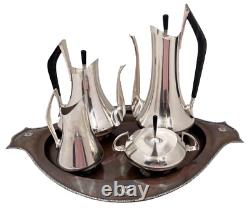


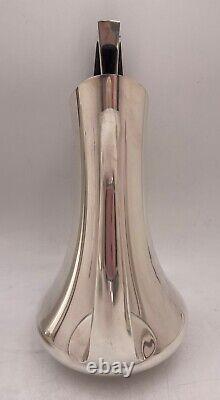
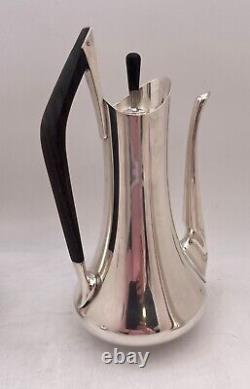
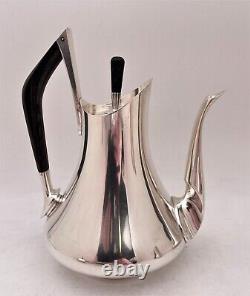
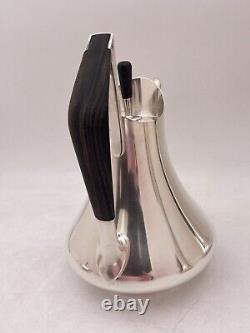


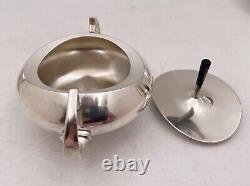

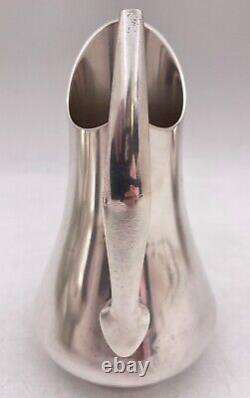
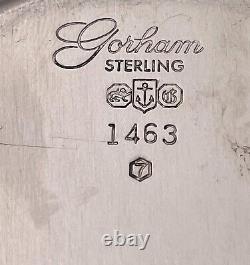
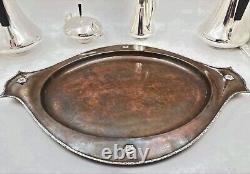

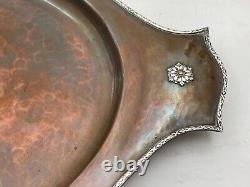



Gorham by Donald Colflesh 5-piece Sterling Tea Set in Mid-Century Modern style from 1967 consisting of. A coffee pot measuring 12'' by 7'.
A tea pot measuring 9 1/2 by 7 1/2'. A creamer measuring 6 1/4'' by 3 3/4'.
A sugar measuring 6 3 /4'' from handle to handle" by 4 1/2" in height. Jones, in Arts & Crafts style. Total silver weight is 87.2 troy ounces. During the heyday of American silver manufacturing-approximately 1850 to 1940-Gorham was one of the most influential.
The White House has used Gorham silver services during many administrations. Grant asked Gorham to commemorate the country's one-hundredth anniversary with a spectacular Century Vase that contained over 2,000 oz (57,000 g) of sterling silver, and in 1899, it produced a grand "loving cup" composed of 70,000 dimes was designed for Admiral George Dewey. Colonel Henry Jewett Furber placed the largest single commission Gorham ever received for what became known as the famous Furber service. The opulent 740-piece service represents Victorian era dining at its most elaborate. The monumental silver and parcel-gilt "Neptune" epergne made for Furber as part of this service was displayed at the Philadelphia Centennial Exposition in 1876.
Gorham artisans also sculpted the famous monument of George Washington in the Capitol's Rotunda. According to the Art Institute of Chicago, which holds this tea set in its permanent collection, "in 1956 Gorham Manufacturing Company, the country's leading maker and retailer of fashionable silver, recruited Donald Colflesh to bring a "contemporary dimension to its traditional products.
Colflesh's most popular and successful design for the firm was the Circa'70 series, in which he brilliantly captured America's ambition to go the moon. In this coffee service, the intersecting angles epitomize the era of space-age design, and the curving, upright thrust of the handles and spouts conveys the aerodynamics of the jet age. Gorham reinforced the coffee service's space-age associations in accompanying pamphlets, noting its feeling of vertical motion. The upward look to space.
The company's name for the line, Circa'70, also confidently alludes to the future and its possibilities. The sleek contours and elongated ebony finials and handles, however, were exceptional for mid-century hollowware and recall similar embellishments on early-20th-century Scandinavian silver. Jones, the maker of the tray, born Albert Edward Jones in 1878 was one of the most notable silversmiths of the 19th century, with his work being synonymous with the Arts and Crafts movement.
He was born into a family of craftsmen and studied at the Birmingham wing of the Central School of Arts and Crafts. He was also a member of the Birmingham Guild of Handicraft. It was in this era that he would study and work alongside a number of key figures such as Arthur Dixon and Edward Taylor, consequently building up a stellar reputation as one of the most promising craftsmen around. He set up his own premises at in Birmingham in 1902, when he also acquired the Jesson and Birkett firm. This attracted various talented prodigies and making his own tools.
Jones Limited continued operating until long after his death in 1954. It was finally being bought up by C J Vander. The company had been taken over by his son in 1958.
Please feel free to ask us any questions, and please see our other listings. This item is in the category "Antiques\Silver\Sterling Silver (.
925)\Tea/Coffee Pots & Sets". The seller is "rere1821" and is located in this country: US. This item can be shipped to United States.
- Brand: Gorham
- Style: Mid-Century Modern
- Composition: Sterling Silver
- Age: Post-1940

